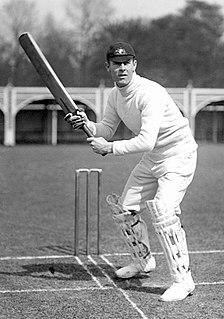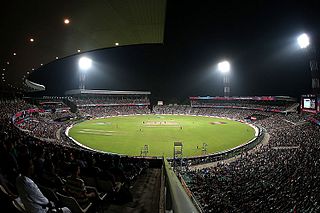
The South African national cricket team, nicknamed the Proteas, is administered by Cricket South Africa. South Africa is a full member of the International Cricket Council (ICC) with Test, One Day International (ODI) and Twenty20 International (T20I) status.
The Kenya national cricket team represents the Republic of Kenya in international cricket. Kenya is an associate member of the International Cricket Council (ICC) which has Twenty20 International (T20I) status after the ICC granted T20I status to all of their members.

The Uganda national cricket team, nicknamed the Cricket Cranes, represents the Republic of Uganda in international cricket. The team is organised by the Uganda Cricket Association, which has been an associate member of the International Cricket Council (ICC) since 1998.

Nathan Michael Hauritz is a former Australian cricketer who has represented Australia in Tests, One-dayers and Twenty20 Internationals. He is mainly noted for his off spin bowling.

Alan Melville was a South African cricketer who played in 11 Tests from 1938 to 1949. He was born in Carnarvon, Northern Cape, South Africa and died at Sabie, Transvaal.
Robert Hector "Bob" Catterall was a South African cricketer who played in 24 Tests from 1922 to 1931.
George Finlay Bissett was a South African cricketer who played in four Test matches in the 1927-28 season. He was born at Kimberley, Cape Province and died at Botha's Hill, Natal.

Quintin McMillan was a South African cricketer who played in thirteen Tests from 1929 to 1931–32.

Sydney Harry "Syd" Curnow was a South African cricketer who played in seven Tests in the 1930–31 and 1931–32 seasons. He was born in Benoni, Transvaal and died at Perth, Western Australia, having emigrated there in the early 1970s. His father was W. S. Curnow, a South African mining engineer, and his mother was a Miss Francis McAuliffe who came from Launceston, Tasmania.
Edward Serrurier "Bob" Newson was a South African cricketer who played in three Tests in 1930–31 and 1938–39.

Denis Stanley Tomlinson was a Rhodesian cricketer who played in one Test for South Africa in 1935. He was the first Rhodesian-born cricketer to represent South Africa.
Eric Quail Davies was a South African cricketer who played in five Tests from 1936 to 1939. He was born in King William's Town and died in Port Alfred, both in Cape Province.
The Combined Services cricket team represents the British armed forces. The team played at first-class level in England for more than forty years in the mid-twentieth century. Their first first-class match was against Gentlemen of England at Lord's in 1920, while their last was against Oxford University at Aldershot in 1964. Combined Services have continued to play cricket thereafter, albeit at minor level.
Peter Gerard Gillespie is a former Irish cricketer. A right-handed batsman and right-arm medium pace bowler, he had played for the Ireland cricket team 116 times up to the start of the 2007 World Cup, including twelve first-class matches and 35 List A matches, four of which were One Day International. Only three players have played more times for Ireland.

The Egypt national cricket team was the team that represented the country of Egypt in international cricket matches. They were active from 1909 until World War II.
Frank Belmont Warne was an Australian first-class cricketer who played for teams on four continents during a 95-game career that stretched from the mid-1920s to the early 1940s.
The International Cavaliers were an ad hoc cricket team made up of famous cricketers in order to encourage local cricket. Their teams included many prominent cricketers from the 1940s, 1950s, 1960s and 1970s as many retired veterans and talented young players were in the team at one point or another. International tours were arranged to South Africa in 1960-61, Africa and India in 1962-63 and the West Indies in 1964-65, 1965–66 and 1969-70. These were usually made up of Test players whose countries were not touring that season or who were not required for their Test side.
Thomas Egerton Seymour Francis played first-class cricket for Somerset, Cambridge University and Eastern Province between 1921 and 1928. He also played four rugby union international matches for England in 1925/26. He was born at Uitenhage, Cape Province, South Africa and died at Bulawayo, Zimbabwe.

Victor Thomas Trumper was an Australian cricketer known as the most stylish and versatile batsman of the Golden Age of cricket, capable of playing match-winning innings on wet wickets his contemporaries found unplayable. Archie MacLaren said of him, "Compared to Victor I was a cab-horse to a Derby winner". Trumper was also a key figure in the foundation of rugby league in Australia. He was the first cricketer to score 7 and 8 centuries in Test match cricket.

The Namibia national cricket team is the team that represents the Republic of Namibia and is governed by Cricket Namibia, an associate member of the International Cricket Council (ICC) since 1992, and became part of the High Performance Program in 2007. They took part in the 2003 Cricket World Cup in South Africa, though they lost all their games. They have played in each edition of the ICC Intercontinental Cup.










